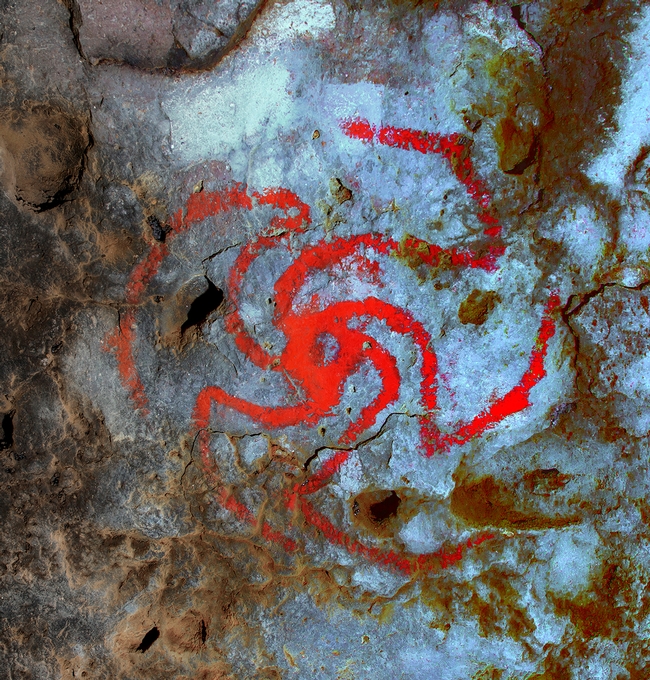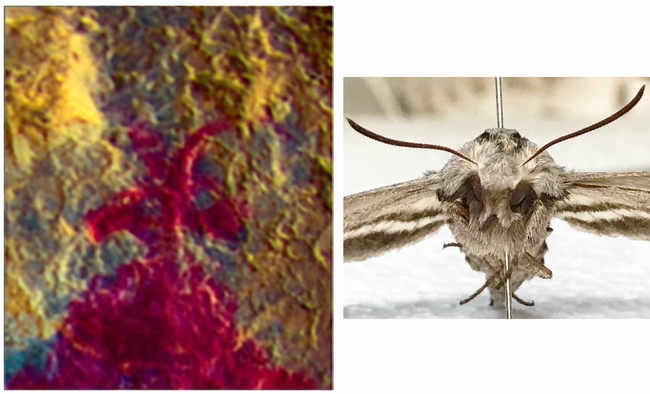An international team of researchers has established a connection between ancient Indian rock art painted in a Kern County cave and a common California plant that was used by Native Americans in their sacred rituals.
This is the first time a hallucinogen has been tied to rock art, the researchers said in their article published in the November 2020 Proceedings of the National Academy of Sciences.
UC Cooperative Extension advisor David Haviland, a Kern County entomology expert, was able to work with the researchers to confirm the notion that one of the images painted on the Pinwheel Cave in Wild Wolves Preserve is likely a sphinx moth, an insect that pollinates Datura. Datura is a genus of plants native to North America that include the common agricultural pest jimson weed (Datura stramonium) and sacred thornapple (Datura wrightii).
“I've experienced hundreds of sphinx moths pollinating Datura,” Haviland said. “The sun starts to go down, the large white flowers open up and attract the moths. Scientists have reported that, after drinking the nectar with their long proboscises, they fly a little erratically, suggesting that, even to the moths, the nectar has a small narcotic effect.”
An image in the cave appears to show a human figure with a sphinx moth head. In another part of the cave, Native Americans painted a bright red pinwheel shape, which the scientists believe depicts a Datura flower as it swirls open. The most telling evidence that connects the Datura to the cave art is dozens of masticated wads of Datura plant fiber that were found pressed into crevices inside the cave.
“This indicates that Datura was ingested in the cave and that the rock painting represents the plant itself, serving to codify communal rituals involving this powerful entheogen,” wrote the researchers in their PNAS article.
Datura is known to have been used by Native American youth when initiated into adulthood, where the root was processed into a tea known historically as toloache. Datura could also be taken throughout their lives to invoke supernatural power for doctoring, counteract negative supernatural events, ward off ghosts or see the future.
Today, Native Americans' descendants recognize the plant's toxicity and no longer ingest Datura, while still respecting their ancestors' knowledge in using a substance that was dangerous and could result in death if the dosage were miscalculated.
“The authors of the article agree: the plant can be highly toxic and should never be consumed,” said David Robinson, United Kingdom archaeologist and the research leader.
Robinson and his team noticed the clumps of fiber, or quids, tucked into crevices on the wall when they were researching Pinwheel Cave in 2007. Quids are commonly found where Native Americans have chewed vegetation to extract nutrition. The scientists analyzed the quids for ancient DNA evidence, but found none. They did discover the wads of vegetation were not comprised of a typical Native dietary staples.
The scientists used three-dimensional digital microscopy on 15 clumps found in the cave, and identified evidence that the Native Americans' chewed and bit the quids with their teeth to extract atropine and scopolamine – two hallucinogenic alkaloids found in Datura. Almost all the samples are Datura wrightii. One exception was a quid of Yucca.
Fifty-six clearly identifiable quids were found in the Pinwheel Cave crevices, but traces of fibrous materials in crevices indicate there were many more in the past that are now gone. Based on radiocarbon dating, the oldest quid studied contained 400-year-old plant material; the newest one was from 130 years ago.
With the scientific analysis of the quids, the researchers were able to interpret the ancient rock art images.
“Rather than the art depicting what is seen in a trance, the pinwheel is likely a representation of the plant causing the trance,” the article says. “The rock art thus established the space where individuals underwent a deeply meaningful first-hand entheogenic experience within the context of an important communal site.”

